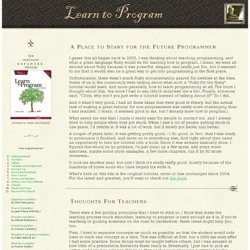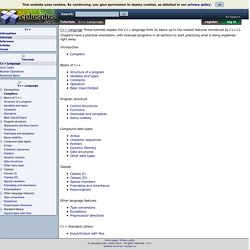

Programming and Web Development Help. Learn to Program, by Chris Pine. A Place to Start for the Future Programmer I guess this all began back in 2002.

I was thinking about teaching programming, and what a great language Ruby would be for learning how to program. I mean, we were all excited about Ruby because it was powerful, elegant, and really just fun, but it seemed to me that it would also be a great way to get into programming in the first place. Unfortunately, there wasn't much Ruby documentation geared for newbies at the time. Some of us in the community were talking about what such a "Ruby for the Nuby" tutorial would need, and more generally, how to teach programming at all. And it wasn't very good. What saved me was that I made it really easy for people to contact me, and I always tried to help people when they got stuck. A couple of years later, it was getting pretty good. :-) So good, in fact, that I was ready to pronounce it finished, and move on to something else.
Thoughts For Teachers About the Original Tutorial Acknowledgements. The Python Tutorial — Python v2.7.1 documentation. Python is an easy to learn, powerful programming language. It has efficient high-level data structures and a simple but effective approach to object-oriented programming. Python’s elegant syntax and dynamic typing, together with its interpreted nature, make it an ideal language for scripting and rapid application development in many areas on most platforms. The Python interpreter and the extensive standard library are freely available in source or binary form for all major platforms from the Python web site, and may be freely distributed.
The same site also contains distributions of and pointers to many free third party Python modules, programs and tools, and additional documentation. The Python interpreter is easily extended with new functions and data types implemented in C or C++ (or other languages callable from C). This tutorial introduces the reader informally to the basic concepts and features of the Python language and system. The Glossary is also worth going through. The Java? Tutorials. The Java Tutorials are practical guides for programmers who want to use the Java programming language to create applications.

They include hundreds of complete, working examples, and dozens of lessons. Groups of related lessons are organized into "trails". The Java Tutorials primarily describe features in Java SE 8. For best results, download JDK 8. What's New The Java Tutorials are continuously updated to keep up with changes to the Java Platform and to incorporate feedback from our readers. Lambda expressions enable you to treat functionality as a method argument, or code as data.
Apart from fixing typos and errors, this update includes also includes the following: The Security trail has been restructured; find security information about applets and Java Web Start applications in the Java Applets lesson. Trails Covering the Basics These trails are available in book form as The Java Tutorial, Fifth Edition. Creating Graphical User Interfaces Specialized Trails and Lessons.
C++ Language Tutorial. This website uses cookies.

By continuing, you give permission to deploy cookies, as detailed in our privacy policy. ok Search: Not logged in C++ Language These tutorials explain the C++ language from its basics up to the newest features introduced by C++11. Introduction Compilers Basics of C++ Program structure Compound data types Classes Other language features C++ Standard Library Input/Output with files Tutorials C++ LanguageAscii CodesBoolean OperationsNumerical Bases C++ Language Introduction:CompilersBasics of C++:Program structure:Compound data types:Classes:Other language features:Standard library:Input/output with files.